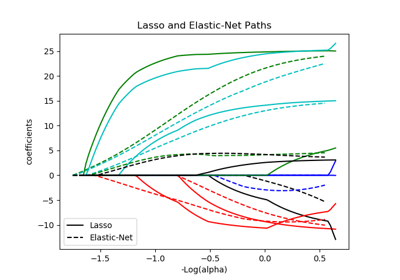sklearn.linear_model.enet_path¶
-
sklearn.linear_model.enet_path(X, y, l1_ratio=0.5, eps=0.001, n_alphas=100, alphas=None, precompute=’auto’, Xy=None, copy_X=True, coef_init=None, verbose=False, return_n_iter=False, positive=False, check_input=True, **params)[source]¶ Compute elastic net path with coordinate descent
The elastic net optimization function varies for mono and multi-outputs.
For mono-output tasks it is:
1 / (2 * n_samples) * ||y - Xw||^2_2 + alpha * l1_ratio * ||w||_1 + 0.5 * alpha * (1 - l1_ratio) * ||w||^2_2
For multi-output tasks it is:
(1 / (2 * n_samples)) * ||Y - XW||^Fro_2 + alpha * l1_ratio * ||W||_21 + 0.5 * alpha * (1 - l1_ratio) * ||W||_Fro^2
Where:
||W||_21 = \sum_i \sqrt{\sum_j w_{ij}^2}
i.e. the sum of norm of each row.
Read more in the User Guide.
Parameters: - X : {array-like}, shape (n_samples, n_features)
Training data. Pass directly as Fortran-contiguous data to avoid unnecessary memory duplication. If
yis mono-output thenXcan be sparse.- y : ndarray, shape (n_samples,) or (n_samples, n_outputs)
Target values
- l1_ratio : float, optional
float between 0 and 1 passed to elastic net (scaling between l1 and l2 penalties).
l1_ratio=1corresponds to the Lasso- eps : float
Length of the path.
eps=1e-3means thatalpha_min / alpha_max = 1e-3- n_alphas : int, optional
Number of alphas along the regularization path
- alphas : ndarray, optional
List of alphas where to compute the models. If None alphas are set automatically
- precompute : True | False | ‘auto’ | array-like
Whether to use a precomputed Gram matrix to speed up calculations. If set to
'auto'let us decide. The Gram matrix can also be passed as argument.- Xy : array-like, optional
Xy = np.dot(X.T, y) that can be precomputed. It is useful only when the Gram matrix is precomputed.
- copy_X : boolean, optional, default True
If
True, X will be copied; else, it may be overwritten.- coef_init : array, shape (n_features, ) | None
The initial values of the coefficients.
- verbose : bool or integer
Amount of verbosity.
- return_n_iter : bool
whether to return the number of iterations or not.
- positive : bool, default False
If set to True, forces coefficients to be positive. (Only allowed when
y.ndim == 1).- check_input : bool, default True
Skip input validation checks, including the Gram matrix when provided assuming there are handled by the caller when check_input=False.
- **params : kwargs
keyword arguments passed to the coordinate descent solver.
Returns: - alphas : array, shape (n_alphas,)
The alphas along the path where models are computed.
- coefs : array, shape (n_features, n_alphas) or (n_outputs, n_features, n_alphas)
Coefficients along the path.
- dual_gaps : array, shape (n_alphas,)
The dual gaps at the end of the optimization for each alpha.
- n_iters : array-like, shape (n_alphas,)
The number of iterations taken by the coordinate descent optimizer to reach the specified tolerance for each alpha. (Is returned when
return_n_iteris set to True).
Notes
For an example, see examples/linear_model/plot_lasso_coordinate_descent_path.py.


